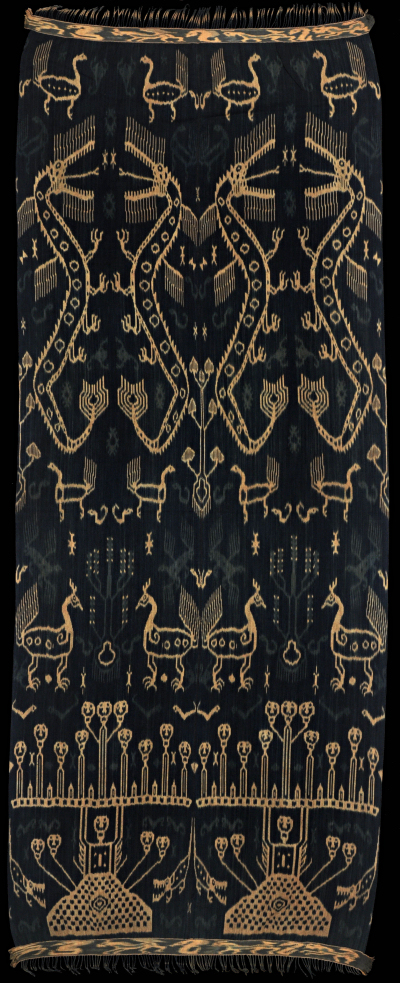| |
 
 | | | |
096 Sumba, East Sumba
Hinggi (men's blanket)  
| | Locale: | Rende. | | Period: | 1960-1970 | | Yarn: | Cotton, hand-spun, medium | | Technique: | Warp ikat | | Panels: | 2 | | Size: | 107 x 270 cm (3' 6" x 8' 10") LW: 2.52 | | Weight: | 1020 g (36.0 oz), 353 g/m2 (1.16 oz/ft2) | | Design: | Hinggi kawuru for royalty in hondu kihhil construction, pagi-sore design, with entirely different top and bottom, ikated over its full length, searah. Hinggi pahudur. Kinga Lauren believes it was made by Tamu Rambu Ana Motur, wife of the Raja of Rende, to whom he was close since adolescence. Named not after the largest motif, but after the most important: andung, skull tree, Large naga, dragons, with flowing forms, ayam, roosters, and buaya, crocodiles. Coloured in two shades of indigo. Ikated kabakil (borders). This unusual piece shows the lower world, represented by pohon andung, skull trees, and crocodiles; the middle world, represented by roosters and flying birds, possibly garuda, and serpents; the upper world is represented by ular galar, winged serpents or dragons, the design of which was inspired by Chinese porcelain. | | Comment: | Warrior's hinggi in two shades of unusually intense indigo. Excellent weaving with perfect alignment of the smallest details. While hinggi done in indigo only are the only kind that commoners were allowed to make, this piece has the signature elements of a nobleman's cloth. The design is rich in in complex detail, intricate and perfectly executed flowing shapes, and both the dyeing and weaving and are exemplary. The two tone indigo creates a level of depth, especially because the darker parts are very dark indeed. Such perfect curves and diagonals are hard to achieve, hence regarded as high class. Noblemen would often prefer to wear one of these, rather than the traditional morinda hinggi, because of the latter's association with burial. In the view of Steven Alpert this hinggi was made by an old school weaver full of daring and imagination, willing to grapple with magic - a descriptiion well-befitting Tambu Ramu Ana Motur, one of the greatest Sumbanese weavers. While the formerly rare kihhil design was revived in the 1970s period because it was (briefly) seen as attractive for the tourist market, the use of hand-spun rather than commercial yarn in this hinggi indicates that it was made, not for the market, but for in-context use. | | Background: | Chapters on Sumba and East Sumba. | | Exhibited: | Hong Kong University Museum and Art Gallery, 2017. | | Published: | Orientations Vol. 46/2014.
Ikat Textiles of the Indonesian Archipelago, 2018.
Noble Virtuosity: Hidden Asymmetry in Ikat from Sumba, 2024. | | Sources: | Background information on royal use of this type in Adams, Classic and eccentric elements in East Sumba textiles, p. 14. | | |

©Peter ten Hoopen, 2025
All rights reserved.
|
|


